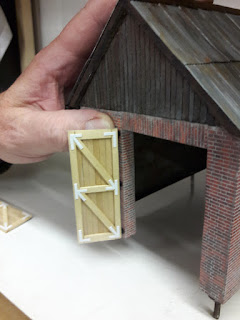Workshop
Crane
Usual tasks:-
Laurence continued with crane fitting - this week it was winch cabling.
He and Stephen discussed the creation of a removable back-wall and floor to make fitting John's workshop equipment a bit easier. A laminated plasticard wall of embossed brickwork and backing sheet was made. This was sized to go in-and-out of the doorways to allow modifications/fitting after the building is bolted down (the missing top section is hardly visible and can be disguised with a painting scheme). After consideration, a raised floor was dismissed due to lack of working space adjacent the rails (for the workmen). Geoff cut out the plaster floor to allow the new floor to be added flush with the existing ground. This will be glued to the back-wall to make a single removable unit. The brazier flue will be modified to exit through the rear wall rather than the roof.
Stephen used a cigarette lighter to heat a length of 2.5mm dia plastic rod and create a swan-neck on the rainwater pipe. Thin electrical wires were twisted around the pipe to represent joints. The RWP was then glued to the gutter and the whole assembly painted.



















